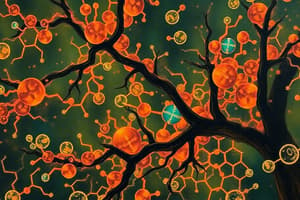Podcast
Questions and Answers
What is the term used to describe the catalytically active form of an enzyme?
What is the term used to describe the catalytically active form of an enzyme?
- Apoenzyme
- Cofactor
- Holoenzyme (correct)
- Substrate
Which factor does NOT affect enzyme activity?
Which factor does NOT affect enzyme activity?
- Volume of reaction mixture (correct)
- Temperature
- Enzyme concentration
- Substrate concentration
What does the optimal temperature refer to in relation to enzyme activity?
What does the optimal temperature refer to in relation to enzyme activity?
- The temperature that allows for maximum enzyme activity (correct)
- The temperature where enzyme denatures
- The temperature that increases substrate interaction
- The temperature where enzyme activity is lowest
Which term describes a substance that can decrease the velocity of an enzyme-catalyzed reaction?
Which term describes a substance that can decrease the velocity of an enzyme-catalyzed reaction?
What does Km represent in enzyme kinetics?
What does Km represent in enzyme kinetics?
What characterizes reversible inhibition?
What characterizes reversible inhibition?
At what temperature range do human enzymes typically show maximum activity?
At what temperature range do human enzymes typically show maximum activity?
Which of the following is NOT a factor affecting enzyme activity?
Which of the following is NOT a factor affecting enzyme activity?
What is the primary role of enzymes in chemical reactions?
What is the primary role of enzymes in chemical reactions?
Which type of enzyme is responsible for transferring functional groups from one molecule to another?
Which type of enzyme is responsible for transferring functional groups from one molecule to another?
How much faster can enzyme-catalyzed reactions proceed compared to uncatalyzed reactions?
How much faster can enzyme-catalyzed reactions proceed compared to uncatalyzed reactions?
What distinguishes a ribozyme from other enzymes?
What distinguishes a ribozyme from other enzymes?
What is the main effect of enzyme inhibition on enzyme activity?
What is the main effect of enzyme inhibition on enzyme activity?
What type of specificity refers to an enzyme's preference for a specific substrate or chemically related molecules?
What type of specificity refers to an enzyme's preference for a specific substrate or chemically related molecules?
Which of the following enzyme classifications comes first in the typical order?
Which of the following enzyme classifications comes first in the typical order?
What is the role of catalysts in chemical reactions?
What is the role of catalysts in chemical reactions?
Flashcards
Apoenzyme
Apoenzyme
The protein part of an enzyme.
Cofactor
Cofactor
The non-protein part of an enzyme, like a metal ion or vitamin.
Holoenzyme
Holoenzyme
The fully active form of an enzyme, combining the apoenzyme and cofactor.
Active Site
Active Site
Signup and view all the flashcards
Enzyme Activity
Enzyme Activity
Signup and view all the flashcards
Enzyme Unit (U)
Enzyme Unit (U)
Signup and view all the flashcards
Km
Km
Signup and view all the flashcards
Inhibitor
Inhibitor
Signup and view all the flashcards
Enzymes
Enzymes
Signup and view all the flashcards
Are most enzymes proteins?
Are most enzymes proteins?
Signup and view all the flashcards
What do enzymes change?
What do enzymes change?
Signup and view all the flashcards
What is the nature of enzyme specificity?
What is the nature of enzyme specificity?
Signup and view all the flashcards
How efficient are enzymes?
How efficient are enzymes?
Signup and view all the flashcards
What is a good example of an efficient enzyme?
What is a good example of an efficient enzyme?
Signup and view all the flashcards
How are enzymes classified?
How are enzymes classified?
Signup and view all the flashcards
What is activation energy?
What is activation energy?
Signup and view all the flashcards
Study Notes
Learning Objectives
- Describe enzymes and their common properties
- List enzyme classifications in correct order
- Describe factors changing enzyme activity
- Explain the relationship between Km and activity
- Explain enzyme inhibition and inhibition types
Metabolic Reactions
- Enzymes catalyze metabolic reactions—both anabolic and catabolic reactions
- Enzymes speed up reactions by lowering activation energy
- Enzymes facilitate biochemical modifications
Glycolysis
- Glycolysis is a metabolic pathway that converts glucose to pyruvate
- Enzymes are involved in each step of glycolysis—facilitating reactions
Activation Energy
- Activation energy is the energy needed for a reaction to occur
- Enzymes decrease activation energy
- Reaction speed increases
- Enzymes are not consumed in the reaction
Activation Energy and Catalysts
- Catalysts speed up reaction rates by decreasing the activation energy
- Enzymes are biocatalysts, acting as catalysts in biological systems
Enzymes
- Enzymes are biocatalysts, increasing reaction rates
- They bind to substrates, speeding up reactions
- They are not consumed in reactions
Properties of Enzymes
- Most enzymes are proteins—an exception is ribozymes (catalytic RNA).
- Enzymes catalyze reactions with high efficiency and specificity
- Enzymes change reaction rate, not equilibrium
Efficiency
- Enzyme-catalyzed reactions are highly efficient, increasing speeds by 10³ to 10⁸ times
- Carbonic anhydrase is a fast enzyme, hydrating 10⁶ CO₂ molecules per second
Specificity
- Reaction specificity: A given enzyme catalyzes a specific reaction type
- Substrate specificity: A given enzyme uses specific molecules or chemically related molecules
Enzyme Nomenclature: Classification
- Enzymes are classified by the type of reaction they catalyze
- An enzyme's classification is represented using an Enzyme Commission (EC) number
Enzyme Structure
- Apoenzyme: Protein part
- Cofactor: Non-protein part
- Holoenzyme: Catalytically active form
- The active site facilitates substrate interaction
Enzyme Structure: Active Site
- Active sites have key amino acids
- Amino acids precisely positioned to interact with substrates
Enzyme Activity
- Activity (V) represents the speed of the reaction
- Measured in µmol substrate converted to product in a given time
- UNIT Activity: Enzyme activity that converts 1 µmol substrate into product in 1 minute, under optimal conditions
Factors Affecting Enzyme Activity
- Enzyme concentration: Increased enzyme increases reaction speed
- Substrate concentration: More substrate increases the reaction speed but only up to a certain point
- Temperature: Optimal temperature maximizes reaction speed
- PH: Optimal pH maximizes reaction speed
- Inhibitors: Substances that reduce enzyme activity
Enzyme Concentration
- Increased enzyme concentration increases reaction speed and product formation
Substrate Concentration
- As substrate concentration increases, the reaction speed increases but is limited by the enzyme availability
- Km represents the substrate concentration where the reaction rate is half its maximal value (½ Vmax)
- Affinity between the enzyme and substrate depends on Km
Temperature
- Optimal temperature maximizes reaction speed
- Excessive heat can inactivate enzymes
pH
- Optimal pH maximizes reaction speed
- Extreme pH values inactivate enzymes
Inhibitors
- Inhibitors decrease enzyme activity
- Reversible inhibitors can be removed from the enzyme
- Irreversible inhibitors permanently inactivate the enzyme
- Competitive inhibitors compete with the substrate for the active site
- Non-competitive inhibitors bind to the enzyme at a site separate from the active site
Reversible Inhibition
- Competitive inhibitors compete for active site
- Non-competitive inhibitors bind at a different site
- Allosteric inhibitors change enzyme shape (non-competitive)
Enzyme Kinetics and Km
- Km reflects the enzyme's affinity for its particular substrate. A smaller Km suggests a higher affinity.
- Vmax represents the maximum reaction rate, limited by enzyme availability.
Km: A Clinical Example
- Enzyme Km values can vary between individuals, having clinical implications depending on the gene.
Regulation of Enzyme Activity
- Enzyme amount: Controlling enzyme synthesis and degradation
- Enzyme modification: Using covalent/non-covalent modifications and allosteric mechanisms
- Compartments: Enzyme localization in various cellular compartments (e.g. Mitochondria, cytosol)
- Isozymes: Enzymes with similar activity but differing enzyme structures
Phosphorylation/Dephosphorylation
- Post-translational modification such as phosphorylation/dephosphorylation (usually covalent) turns the enzyme "on" or "off"
Feed-Back Inhibition/Feed-forward activation
- The end-product of a chain of enzyme reactions can inhibit early enzyme in the chain
- To prevent the buildup of unused or unnecessary products
- To save energy
- Feed-forward activation is a regulatory mechanism where an intermediate in a metabolic pathway activates an enzyme further down the pathway.
- This allows for the coordinated regulation of metabolic processes.
Compartments
- Enzymes located in different cell compartments may have different activity based on location and the processes involved
Isozymes
- Enzymes with similar functions, but slightly different structures, enabling them to be useful in various aspects (e.g. heart and skeletal muscle)
Studying That Suits You
Use AI to generate personalized quizzes and flashcards to suit your learning preferences.




